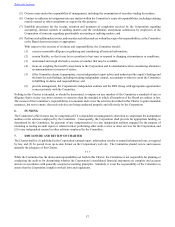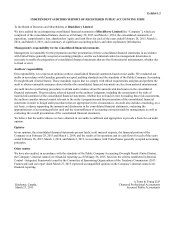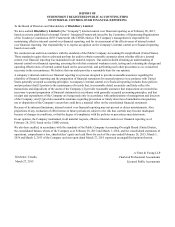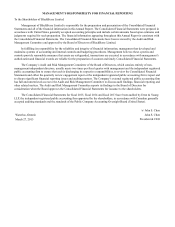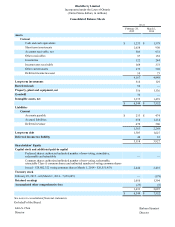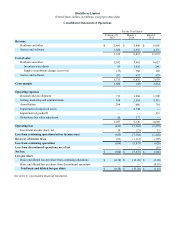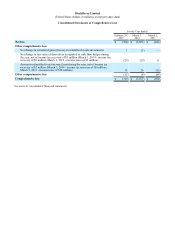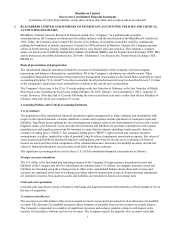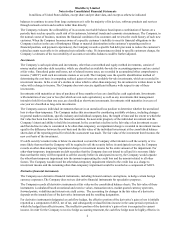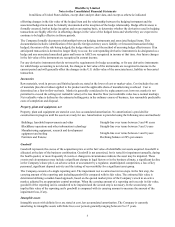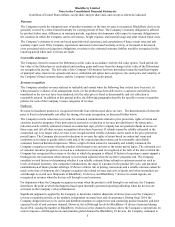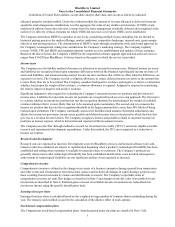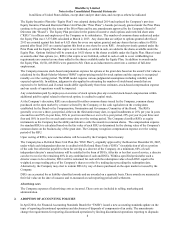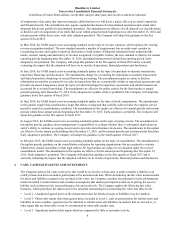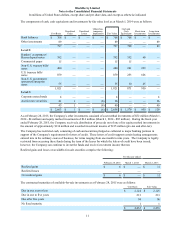Blackberry 2015 Annual Report Download - page 76
Download and view the complete annual report
Please find page 76 of the 2015 Blackberry annual report below. You can navigate through the pages in the report by either clicking on the pages listed below, or by using the keyword search tool below to find specific information within the annual report.1
BlackBerry Limited
Notes to the Consolidated Financial Statements
In millions of United States dollars, except share and per share data, and except as otherwise indicated
1. BLACKBERRY LIMITED AND SUMMARY OF SIGNIFICANT ACCOUNTING POLICIES AND CRITICAL
ACCOUNTING ESTIMATES
BlackBerry Limited, formerly Research In Motion Limited, (the “Company”) is a global leader in mobile
communications, the Company revolutionized the mobile industry with the introduction of the BlackBerry® solution in
1999. Today, the Company aims to inspire the success of its millions of customers around the world by continuously
pushing the boundaries of mobile experiences. Founded in 1984 and based in Waterloo, Ontario, the Company operates
offices in North America, Europe, Middle East and Africa, Asia Pacific and Latin America. The Company’s common
shares are listed on the NASDAQ Global Select Market (NASDAQ: BBRY) and the Toronto Stock Exchange (TSX: BB),
and its unsecured convertible debentures due 2020 (the “Debentures”) are listed on the Toronto Stock Exchange (TSX:
BB.DB.U).
Basis of presentation and preparation
The consolidated financial statements include the accounts of all subsidiaries of the Company with intercompany
transactions and balances eliminated on consolidation. All of the Company’s subsidiaries are wholly-owned. These
consolidated financial statements have been prepared by management in accordance with United States generally accepted
accounting principles (“U.S. GAAP”) on a basis consistent for all periods presented except as described in note 2. Certain
of the comparative figures have been reclassified to conform to the current year’s presentation.
The Company’s fiscal year is the 52 or 53 weeks ending on the last Saturday of February, or the first Saturday of March.
Most fiscal years, including the fiscal years ending February 28, 2015, March 1, 2014 and March 2, 2013, comprise 52
weeks. However, if the date that is 52 weeks following the most recent fiscal year end is earlier than the last Saturday of
February, then such fiscal year comprises 53 weeks.
Accounting Policies and Critical Accounting Estimates
Use of estimates
The preparation of the consolidated financial statements requires management to make estimates and assumptions with
respect to the reported amounts of assets, liabilities, revenues and expenses and the disclosure of contingent assets and
liabilities. Significant areas requiring the use of management estimates relate to the determination of reserves for various
litigation claims, provisions for excess and obsolete inventories and liabilities for purchase commitments with contract
manufacturers and suppliers, provisions for warranty, revenue related estimates including vendor-specific objective
evidence of selling price (“VSOE”), best estimated selling price (“BESP”), right of return and customer incentive
commitments, royalties, implied fair value of goodwill, long-lived asset impairment, amortization expense, fair values of
assets acquired and liabilities assumed in business combinations, provision for income taxes, realization of deferred
income tax assets and the related components of the valuation allowance, allowance for doubtful accounts, and the fair
values of financial instruments. Actual results could differ from these estimates.
The significant accounting policies used in these U.S. GAAP consolidated financial statements are as follows:
Foreign currency translation
The U.S. dollar is the functional and reporting currency of the Company. Foreign currency denominated assets and
liabilities of the Company and all of its subsidiaries are translated into U.S. dollars. Accordingly, monetary assets and
liabilities are translated using the exchange rates in effect at the consolidated balance sheets dates and revenues and
expenses are translated at the rates of exchange prevailing when the transactions occurred. Remeasurement adjustments
are included in income. Non-monetary assets and liabilities are translated at historical exchange rates.
Cash and cash equivalents
Cash and cash equivalents consist of balances with banks and liquid investments with maturities of three months or less at
the date of acquisition.
Accounts receivable, net
The accounts receivable balance reflects invoiced and accrued revenue and is presented net of an allowance for doubtful
accounts. The allowance for doubtful accounts reflects estimates of probable losses in the accounts receivable balance.
The Company is dependent on a number of significant customers and on large complex contracts with respect to the
majority of its products, software and service revenues. The Company expects the majority of its accounts receivable


